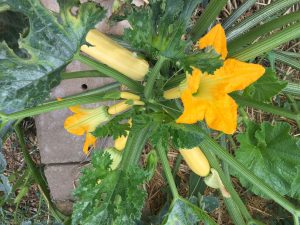We tend to think of individual plants and trees as growing in the spot they were sown, without any influence on or from the plants around them. But plants have a definite effect on each other in the wild and in our gardens. Driving through the Napa Valley wine country, you will notice that many vineyards have rose bushes planted around them. Although this enhances the beauty of the countryside, that isn’t why they are there. They are planted to attract pollinators to the vines which improves grape production.
Peter Wohlleben, in his book, “The Hidden Life of Trees” (Copyright 2015 by Ludwig Verlag, Munich) describes the amazing interconnectedness of a forest of trees. There is a whole network of underground fungal threads, which provide sugars and nutrients to the trees. The trees, in turn, provide the fungi with carbohydrates. This symbiotic relationship is called “the wood wide web.” This web has developed over hundreds and hundreds of years.
In the garden, we plant from season to season, so there’s a much shorter time to develop such a web. But we can create a kind of symbiosis by planting companions – plants that “help” each other, whether by providing shade, nutrients or attracting beneficial pollinators. Some plants also repel unwanted or harmful insects. Marigolds, for instance, are great insect repellents and help keep them away from vegetables such as kale, parsley and Swiss chard.
Some Native American communities have traditionally planted “The Three Sisters:” corn, beans and squash. Planted together they complement each other in the garden as well as nutritionally. The corn provides stalks as structures for the beans to climb so they are not out-competed by the sprawling squash vines below.
The beans provide nitrogen to the soil and stabilize the tall corn during heavy winds. The beans also are nitrogen-fixers hosting rhizobia (rod-shaped bacteria) on their roots that can take nitrogen from the air and convert it into forms that can be absorbed by plant roots. The leaves of the corn stalks and squash leaves shade the ground and so, help to retain moisture.
According to the Web site, “Native Seeds/SEARCH,” The Iroquois tribes used these three plants as their main culinary diet. “A diet of corn, beans and squash is complete and balanced. Corn provides carbohydrates and the dried beans are rich in protein and have amino acids that are absent from corn. Squash provides different vitamins and minerals than corn and beans.”
Companion plants for a vegetable garden include a mixture of flowers and vegetables. Pests have more trouble finding vegetables if there are flowers that attract beneficial insects to the garden.
Companion plants for beans include marigolds, nasturtium, rosemary and summer savory.
Companion plants for beets are any variety of garlic. Carrots are helped by planting chives and sage close by. Celery plants are protected by chives, garlic and nasturtium, which deter bugs and aphids.
Cucumbers benefit from marigold, nasturtium and oregano. Chamomile and summer savory improve the growth and flavor of onions. Calliopsis is a good companion for tomatoes, peppers or fall crops. You can find a more complete list of pairings at the Burpee site, www.burpee.ocm/blog/article10888.html.
So, before beginning a vegetable garden, it would be wise to look into shrubs and flowers that may benefit your veggies. Not only are they helpful to the fruits and vegetables that you decide to plant, but the flowers will brighten up the appearance of the garden
Sources: “Great Garden Companions” by Sally Jean Cunningham, Master Gardener, Cornell Cooperative Extension.
Francie McGowan is a University of California Cooperative Extension Master Gardener of Tuolumne County.
UCCE Master Gardeners of Tuolumne and Calaveras Counties can answer home gardening questions. Call 209-533-5912 or fill out our easy-to-use problem questionnaire here. Check out our website here. You can also find us on Facebook.

